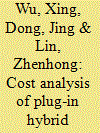|
|
|
Sort Order |
|
|
|
Items / Page
|
|
|
|
|
|
|
| Srl | Item |
| 1 |
ID:
105798


|
|
|
|
|
| Publication |
2011.
|
| Summary/Abstract |
A spatially explicit agent-based vehicle consumer choice model is developed to explore sensitivities and nonlinear interactions between various potential influences on plug-in hybrid vehicle (PHEV) market penetration. The model accounts for spatial and social effects (including threshold effects, homophily, and conformity) and media influences. Preliminary simulations demonstrate how such a model could be used to identify nonlinear interactions among potential leverage points, inform policies affecting PHEV market penetration, and help identify future data collection necessary to more accurately model the system. We examine sensitivity of the model to gasoline prices, to accuracy in estimation of fuel costs, to agent willingness to adopt the PHEV technology, to PHEV purchase price and rebates, to PHEV battery range, and to heuristic values related to gasoline usage. Our simulations indicate that PHEV market penetration could be enhanced significantly by providing consumers with ready estimates of expected lifetime fuel costs associated with different vehicles (e.g., on vehicle stickers), and that increases in gasoline prices could nonlinearly magnify the impact on fleet efficiency. We also infer that a potential synergy from a gasoline tax with proceeds is used to fund research into longer-range lower-cost PHEV batteries.
|
|
|
|
|
|
|
|
|
|
|
|
|
|
|
|
| 2 |
ID:
133101


|
|
|
|
|
| Publication |
2014.
|
| Summary/Abstract |
Using spatial, longitudinal travel data of 415 vehicles over 3-18 months in the Seattle metropolitan area, this paper estimates the operating costs of plug-in hybrid electric vehicles (PHEVs) of various electric ranges (10, 20, 30, and 40 miles) for 3, 5, and 10 years of payback period, considering different charging infrastructure deployment levels and gasoline prices. Some key findings were made. (1) PHEVs could help save around 60% or 40% in energy costs, compared with conventional gasoline vehicles (CGVs) or hybrid electric vehicles (HEVs), respectively. However, for motorists whose daily vehicle miles traveled (DVMT) is significant, HEVs may be even a better choice than PHEV40s, particularly in areas that lack a public charging infrastructure. (2) The incremental battery cost of large-battery PHEVs is difficult to justify based on the incremental savings of PHEVs' operating costs unless a subsidy is offered for large-battery PHEVs. (3) When the price of gasoline increases from $4/gallon to $5/gallon, the number of drivers who benefit from a larger battery increases significantly. (4) Although quick chargers can reduce charging time, they contribute little to energy cost savings for PHEVs, as opposed to Level-II chargers.
|
|
|
|
|
|
|
|
|
|
|
|
|
|
|
|
| 3 |
ID:
150903


|
|
|
|
|
| Summary/Abstract |
Smart-grid and electric-vehicle technologies are rapidly diffusing, yet important policy implications remain to be fully analyzed. This multi-year field study sought to fill part of this gap by exploring human adaptation to plug-in hybrid electric vehicle (PHEV) performance and vehicle charging in smart-grid environments. Homes were equipped with smart meters in a smart-grid experiment conducted by the local utility. Study households were organized by either standard or time-of-use electricity pricing, and randomly assigned to “managed” or “unmanaged” charging scenarios. Using a mixed-methods approach, study data were collected through vehicle data loggers, smart-plugs interviews, and questionnaires. The paper describes vehicle operations and performance; the ways in which households managed PHEV charging; and the manner in which they responded to smart-grid, smart-plug, and dashboard feedback. Findings indicate that households actively managed PHEV charging; however, they preferred flexible charging scenarios. Charging-management decisions were influenced by electricity-pricing. Online feedback on household- and vehicle-electricity consumption was generally ignored, but drivers responded to dashboard feedback as they drove. These results provide empirical bases for government and corporate policymakers to improve policy decisions relative to PHEV impacts on electricity loads, design of smart-grid feedback, and design of charging infrastructures.
|
|
|
|
|
|
|
|
|
|
|
|
|
|
|
|
| 4 |
ID:
088264


|
|
|
|
|
| Publication |
2009.
|
| Summary/Abstract |
Plug-in hybrid electric vehicle (PHEV) technology is receiving attention as an approach to reducing US dependency on foreign oil and greenhouse gas (GHG) emissions from the transportation sector. PHEVs require large batteries for energy storage, which affect vehicle cost, weight, and performance. We construct PHEV simulation models to account for the effects of additional batteries on fuel consumption, cost, and GHG emissions over a range of charging frequencies (distance traveled between charges). We find that when charged frequently, every 20 miles or less, using average US electricity, small-capacity PHEVs are less expensive and release fewer GHGs than hybrid electric vehicles (HEVs) or conventional vehicles. For moderate charging intervals of 20-100 miles, PHEVs release fewer GHGs, but HEVs have lower lifetime costs. High fuel prices, low-cost batteries, or high carbon taxes combined with low-carbon electricity generation would make small-capacity PHEVs cost competitive for a wide range of drivers. In contrast, increased battery specific energy or carbon taxes without decarbonization of the electricity grid would have limited impact. Large-capacity PHEVs sized for 40 or more miles of electric-only travel do not offer the lowest lifetime cost in any scenario, although they could minimize GHG emissions for some drivers and provide potential to shift air pollutant emissions away from population centers. The tradeoffs identified in this analysis can provide a space for vehicle manufacturers, policymakers, and the public to identify optimal decisions for PHEV design, policy and use. Given the alignment of economic, environmental, and national security objectives, policies aimed at putting PHEVs on the road will likely be most effective if they focus on adoption of small-capacity PHEVs by urban drivers who can charge frequently.
|
|
|
|
|
|
|
|
|
|
|
|
|
|
|
|
| 5 |
ID:
105821


|
|
|
|
|
| Publication |
2011.
|
| Summary/Abstract |
This paper uses a new unit commitment model which can simulate the interactions among plug-in hybrid electric vehicles (PHEVs), wind power, and demand response (DR). Four PHEV charging scenarios are simulated for the Illinois power system: (1) unconstrained charging, (2) 3-hour delayed constrained charging, (3) smart charging, and (4) smart charging with DR. The PHEV charging is assumed to be optimally controlled by the system operator in the latter two scenarios, along with load shifting and shaving enabled by DR programs. The simulation results show that optimally dispatching the PHEV charging load can significantly reduce the total operating cost of the system. With DR programs in place, the operating cost can be further reduced.
|
|
|
|
|
|
|
|
|
|
|
|
|
|
|
|
| 6 |
ID:
124369


|
|
|
|
|
| Publication |
2013.
|
| Summary/Abstract |
We compare the potential of hybrid, extended-range plug-in hybrid, and battery electric vehicles to reduce lifetime cost and life cycle greenhouse gas emissions under various scenarios and simulated driving conditions. We find that driving conditions affect economic and environmental benefits of electrified vehicles substantially: Under the urban NYC driving cycle, hybrid and plug-in vehicles can cut life cycle emissions by 60% and reduce costs up to 20% relative to conventional vehicles (CVs). In contrast, under highway test conditions (HWFET) electrified vehicles offer marginal emissions reductions at higher costs. NYC conditions with frequent stops triple life cycle emissions and increase costs of conventional vehicles by 30%, while aggressive driving (US06) reduces the all-electric range of plug-in vehicles by up to 45% compared to milder test cycles (like HWFET). Vehicle window stickers, fuel economy standards, and life cycle studies using average lab-test vehicle efficiency estimates are therefore incomplete: (1) driver heterogeneity matters, and efforts to encourage adoption of hybrid and plug-in vehicles will have greater impact if targeted to urban drivers vs. highway drivers; and (2) electrified vehicles perform better on some drive cycles than others, so non-representative tests can bias consumer perception and regulation of alternative technologies. We discuss policy implications.
|
|
|
|
|
|
|
|
|
|
|
|
|
|
|
|
| 7 |
ID:
098564


|
|
|
|
|
| Publication |
2010.
|
| Summary/Abstract |
This study investigates consequences of integrating plug-in hybrid electric vehicles (PHEVs) in a wind-thermal power system supplied by one quarter of wind power and three quarters of thermal generation. Four different PHEV integration strategies, with different impacts on the total electric load profile, have been investigated. The study shows that PHEVs can reduce the CO2-emissions from the power system if actively integrated, whereas a passive approach to PHEV integration (i.e. letting people charge the car at will) is likely to result in an increase in emissions compared to a power system without PHEV load. The reduction in emissions under active PHEV integration strategies is due to a reduction in emissions related to thermal plant start-ups and part load operation. Emissions of the power sector are reduced with up to 4.7% compared to a system without PHEVs, according to the simulations. Allocating this emission reduction to the PHEV electricity consumption only, and assuming that the vehicles in electric mode is about 3 times as energy efficient as standard gasoline operation, total emissions from PHEVs would be less than half the emissions of a standard car, when running in electric mode.
|
|
|
|
|
|
|
|
|
|
|
|
|
|
|
|
| 8 |
ID:
105796


|
|
|
|
|
| Publication |
2011.
|
| Summary/Abstract |
In this study we explore the effects of different charging behaviors of PHEVs in the United States on electricity demand profiles and energy use, in terms of time of day and location (at home, the workplace, or public areas). Based on driving behavior statistics on vehicle distance traveled and daily trips (US DOT, 2003) in the US, we develop a simulation algorithm to estimate the PHEV charging profiles of electricity demand with plausible plug-in times and depth of discharge of the PHEVs.
The model enables simulations of the impacts of various grid management strategies on the availability of vehicle charging in public places, the charge power levels and standards, scheduling charging in off-peak periods and policy measures to promote PHEV adoption. PHEV charging imposes a modest pressure on system load on the order of 560-910 Wp per vehicle. We find that enabling charging in places other than home increases the daily electric energy use of PHEV from 24% to 29% (1.5-2 kWh/day). Major findings of the different scenarios are that PHEVs with a 20 mile range (PHEV-20) shift 45-65% of vehicle miles traveled in the United States to electricity, compared with 65-80% for PHEVs with a 40 mile range (PHEV-40).
|
|
|
|
|
|
|
|
|
|
|
|
|
|
|
|
| 9 |
ID:
094208


|
|
|
|
|
| Publication |
2010.
|
| Summary/Abstract |
In 2009 the U.S. federal government enacted tax credits aimed at encouraging consumers to purchase plug-in hybrid electric vehicles (PHEVs). These tax credits are available to all consumers equally and therefore do not account for the variability in social benefits associated with PHEV operation in different parts of the country. The tax credits also do not consider variability in consumer income. This paper discusses why the PHEV subsidy policy would have higher social benefits at equal or less cost if the tax credits were offered at different levels depending on consumer income and the location of purchase. Quantification of these higher social benefits and related policy proposals are left for future work.
|
|
|
|
|
|
|
|
|
|
|
|
|
|
|
|
|
|
|
|
|